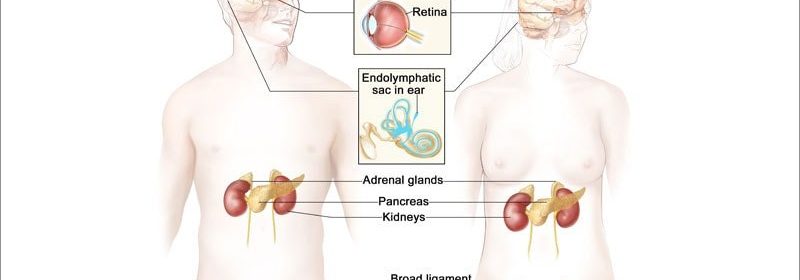Novel Agent May Be Game-Changer in Rare Genetic Disease

A novel oral agent may represent a game-changer for patients with von Hippel-Lindau (VHL) disease, a rare genetic disorder that increases the risk of renal cell carcinoma and other cancers, a new phase 2 trial suggests.
The majority of patients with VHL who received belzutifan (Welireg), a hypoxia-inducible factor 2α inhibitor that targets the transcription factor driving the progression of clear-cell renal cell carcinoma, exhibited a strong response to the drug with minimal adverse events.
“Patients with von Hippel-Lindau disease are at risk of developing several types of cancer and require repeated surgical procedures to manage their tumors,” Eric Jonasch, MD, professor of genitourinary medical oncology at the University of Texas MD Anderson Cancer Center, Houston, said in a statement. “These results [will] profoundly change the way we manage patients with VHL disease and will provide an impactful benefit to a majority of patients with VHL.”
The novel agent received US Food and Drug Administration approval in August following a phase 1 safety and efficacy study. The drug was approved for adults with VHL who require therapy for associated renal cell carcinoma, central nervous system hemangioblastomas, or pancreatic neuroendocrine tumors, but do not need immediate surgery.
The new phase 2 open-label study, published online November 25 in the New England Journal of Medicine, explored the drug’s safety and efficacy profile in 61 patients with VHL. At baseline, patients had a median of 2 renal cell carcinoma target tumors, 1 pancreatic target lesion, and 1.5 central nervous system target hemangioblastomas. Almost all patients (97%) had undergone at least one prior tumor reduction procedure.
Patients received 120 mg a day of belzutifan until disease progression, unacceptable toxicity, or the decision to withdraw from treatment. At a median follow-up of 21.8 months, 54 patients (89%) were still receiving treatment.
Overall, the median response time was 8.2 months, and the median duration of response was not reached at study endpoint. At 24 months, 96% of patients were alive with no signs of disease progression.
At the study endpoint, 30 patients had confirmed partial responses, representing an objective response in renal cell carcinoma of 49%. Another 30 patients displayed a best response of stable disease. More than 75% of patients with pancreatic lesions (47 of 61) also achieved an objective response, as did 30% of those with central nervous system hemangioblastomas.
Only 2 patients (3%) showed disease progression while on treatment, 1 of whom had initially exhibited a partial response.
During treatment, the median linear growth rate of tumors was -3.7 mm per year compared with 3.6 mm per year prior to treatment. However, tumor response rates varied. For example, among patients who achieved a partial response while on treatment, the median linear growth rate improved from 4.1 mm per year before treatment to -5.6 mm per year during treatment. The median linear growth rate was also reduced among patients who responded to treatment with stable disease, going from a median of 3.4 mm per year before treatment to -1.6 mm on treatment.
The most common adverse events were anemia, fatigue, headache, and dizziness. Almost all were grade 1 or 2.
All patients showed a decrease in hemoglobin levels of at least 1.9 g/dL during the first 13 weeks of treatment, which eventually stabilized. However, this drop was expected, the authors noted, as belzutifan inhibits the EPO gene, which reduces the production of erythropoietin.
Based on the results of this phase 2 trial, “patients with VHL are able to have a better quality of life as this therapy can delay or avoid the need for surgery,” Jonasch said. “I am excited to be able to provide this impactful therapy to patients who have waited a long time for new [treatment] options.”
In an accompanying editorial, Manuela Schmidinger, MD, Department of Urology, Medical University of Vienna, Austria, noted that similar response rates have been reported in patients with VHL-associated renal cell carcinoma treated with antiangiogenic agents, such as pazopanib (Votrient).
However, Schmidinger pointed out several benefits to belzutifan over pazopanib. First, the novel agent was associated with fewer and less serious adverse events than pazopanib. The percentage of patients who continued to receive belzutifan at the study endpoint was also much higher — 89% compared with 32% of patients treated with pazopanib. Plus, fewer patients treated with belzutifan required a dose reduction.
Schmidinger also stressed that the current standard of care for VHL patients is limited to surgery, radiofrequency, or microwave ablation, which means patients may undergo multiple invasive interventions over many years that can cause severe disabilities, including visual and acoustic impairments.
Indeed, the number of procedures undergone by patients in the current study dropped from 327 interventions before treatment to only 3 after treatment began.
Given these results, “early and possibly even intermittent use of belzutifan may spare patients with VHL disease multiple surgeries, decrease their risk of loss of organ function (such as renal failure and blindness), and reduce their risk of death from metastatic renal cell carcinoma or CNS hemangioblastomas,” Schmidinger concludes.
The study was funded by Merck, Sharp and Dohme. Jonasch reported serving as a consultant to Merck, Pfizer Inc, Novartis AG, among other companies, and receiving research/grant support from Merck Inc NiKang, Novartis AG and Telix. Several other co-authors reported relationships with industry. Schmidinger reported relationships with Bristol-Myers Squibb, Eisai, EUSA Pharma, Ipsen Biopharmaceuticals, Merck, Merck Sharp & Dohme, and Pfizer.
N Engl J Med. Published online November 25, 2021. Abstract, Editorial
For more from Medscape Oncology, join us on Twitter and Facebook
Source: Read Full Article